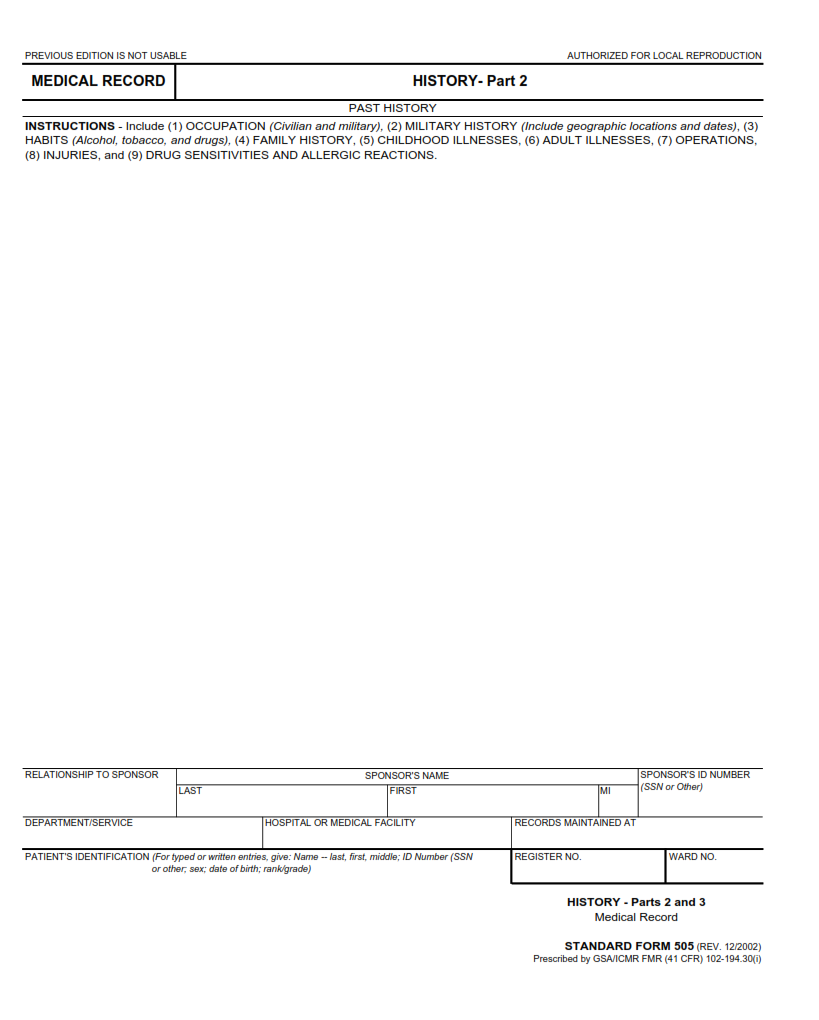SFFORMS.COM – SF 505 Form – Medical Record – History – Parts 2 and 3 – In the medical field, patient records play a crucial role in ensuring accurate diagnoses and effective treatment plans. The SF 505 form is a standard document used by healthcare providers to record essential medical information about their patients. Specifically, parts 2 and 3 of the form focus on documenting a patient’s medical history.
Download SF 505 Form – Medical Record – History – Parts 2 and 3
| Form Number | SF 505 Form |
| Form Title | Medical Record – History – Parts 2 and 3 |
| File Size | 543 KB |
| Date | 12/2002 |
What is a SF 505 Form?
A SF 505 form is a medical record used by the government to track an individual’s health history. This form contains three sections, with parts two and three being the most important ones. Part two of the SF 505 form is where the healthcare provider records all relevant medical information about the patient, including their medical history, allergies, surgeries, and medications they are currently taking.
Part three of the SF 505 form is where healthcare providers record any vaccinations or immunizations that have been administered to the patient. This section is especially important for individuals who travel internationally as many countries require proof of certain vaccinations before allowing entry.
Overall, the SF 505 form serves as a comprehensive record of an individual’s health history and can be requested by various government agencies such as military recruitment offices or immigration departments. It is essential for patients to ensure that their healthcare providers accurately fill out this form to avoid any potential issues with obtaining necessary documentation in the future.
What is the Purpose of SF 505 Form?
Part 2 of the SF 505 form provides a comprehensive medical record history that is used by healthcare providers to accurately diagnose and treat patients. It is important that this information remains confidential and only shared with authorized individuals. Patients are required to provide accurate and complete information about their past medical history, including any current medications, allergies, surgeries, hospitalizations, and family medical history. This data helps doctors make informed decisions about treatment plans.
Part 3 of the SF 505 form allows patients to give permission for specific individuals or organizations to access their medical records. This can include insurance companies, legal representatives, or other healthcare providers involved in the patient’s care. Patients must sign this section if they wish to release their medical records to any third-party entity. It is important for patients to understand that providing false or incomplete information on this form could have serious consequences for their health care treatment plan.
Where Can I Find a SF 505 Form?
If you’re looking for an SF 505 form, chances are that you need to complete the medical record history parts two and three. These sections require detailed information about your medical history, including past illnesses, surgeries, treatments, medications, allergies and other important health data.
One of the easiest ways to find this form is to visit the official website of the Federal Government’s General Services Administration (GSA). You can access a variety of government-issued forms through their online portal. Another option is to inquire at your healthcare provider’s office or hospital as they may have access to this particular form.
It’s important to note that these forms may not be available in every location or jurisdiction. Some states may have their own version of this form which could be used instead. If you’re unsure about where to obtain an SF 505 Form or which version applies in your area, it’s always best practice to consult with a legal professional for guidance.
SF 505 Form – Medical Record – History – Parts 2 and 3
Part 2 of the SF 505 form focuses on the medical history of the patient. This section is divided into different categories such as general, neurological, cardiovascular, and respiratory systems. The healthcare provider is required to provide information about any previous surgeries or hospitalizations that the patient has undergone in order to have a complete record. Other important details such as allergies and medication history are also included in Part 2.
Moving on to Part 3 of the SF 505 form, this covers various medical examinations and tests that were conducted during the patient’s visit. This includes laboratory exams, X-rays, ultrasounds, electrocardiograms (ECGs), and other diagnostic procedures that can provide additional information about a patient’s health status. In this section, relevant findings from these tests are documented along with their corresponding results.
Overall, Parts 2 and 3 of the SF 505 form are crucial components that help ensure comprehensive recording of medical information for each patient visit. Providing accurate data in these sections not only helps healthcare providers manage their patients’ health more effectively but also aids in better decision-making regarding treatment options for patients.
SF 505 Form Example
